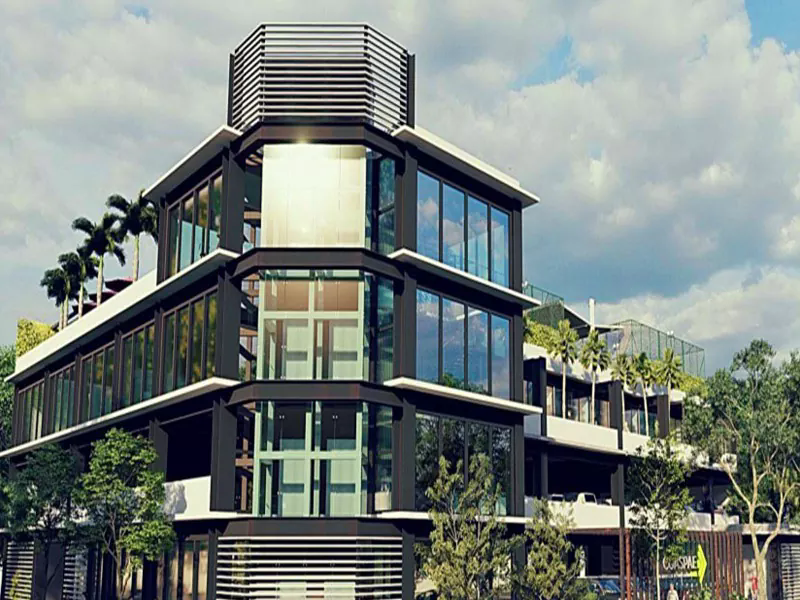Why Are Steel Frame Buildings Becoming the Future of Modern Construction?
2025-02-21
In recent years, steel frame buildings have increasingly become the preferred choice for commercial, industrial, and even residential construction projects. Their strength, durability, and design flexibility have made them a staple in the construction industry. But why are steel frame buildings becoming such a dominant force in modern construction, and what makes them so attractive compared to other building materials? How has steel managed to surpass traditional materials like wood and concrete in so many applications?
What is a Steel Frame Building?
A steel frame building is a structure where the primary support system is made of steel beams and columns. The frame provides the skeleton of the building, supporting both the floors and the roof. Steel frames can be designed for various types of structures, including warehouses, office buildings, residential homes, and even skyscrapers. Steel frames are often preferred because of their ability to withstand heavy loads, resist harsh weather conditions, and be molded into various shapes and designs.
Steel frame buildings have been around for more than a century, but recent advancements in steel technology, as well as a growing focus on sustainability and cost-effectiveness, have made them more popular than ever. But what exactly makes these buildings so valuable in today's world?
Why Are Steel Frame Buildings Gaining Popularity?
1. Strength and Durability
One of the main reasons steel frame buildings are favored is their unmatched strength. Steel is one of the most robust construction materials available, offering superior resistance to bending, breaking, or collapsing under pressure. Steel frames are especially well-suited for buildings that need to endure heavy loads or resist harsh environmental conditions like high winds, earthquakes, or extreme temperatures.
Compared to wood or concrete, steel is more resistant to corrosion, rot, and insect infestations. This means that a steel frame building has a longer lifespan and requires less maintenance over time, offering significant long-term savings for building owners.
2. Design Flexibility
Steel's inherent flexibility makes it an ideal material for architects and engineers who need to design large, open spaces without the need for internal support columns. With steel, it is possible to create wide spans without the constraints of load-bearing walls or posts. This opens up a world of possibilities for unique designs, from expansive interior spaces to the creation of aesthetically pleasing structures.
Steel frame buildings also allow for easier modifications and expansions. If a building’s purpose changes over time—say, from an office space to a manufacturing facility—the layout can be adjusted without major structural challenges. This adaptability is a significant advantage for businesses that expect to grow or change over the years.
3. Faster Construction Times
Another key advantage of steel frame buildings is the speed at which they can be constructed. Steel components are prefabricated off-site in factories, meaning they are ready to be assembled quickly when delivered to the construction site. This reduces the time spent on-site, which can be especially beneficial for projects with tight deadlines.
The quicker assembly time also translates into reduced labor costs and faster project completion. For businesses and organizations looking to move into a new facility quickly, steel frame buildings provide a significant time advantage over traditional construction methods.
4. Cost-Effectiveness
While the initial costs of steel frame buildings can be higher than traditional wood or concrete structures, the long-term savings can make them more cost-effective in the end. Due to their durability and lower maintenance requirements, steel buildings typically have a lower total cost of ownership over their lifespan. This makes them an excellent investment for commercial or industrial properties where long-term financial considerations are key.
Additionally, the energy efficiency of steel frame buildings contributes to their cost-effectiveness. Steel structures are easier to insulate and more energy-efficient, which can lead to lower heating and cooling costs over time. Steel’s ability to provide tight seals against air leaks also contributes to improved energy performance.
5. Sustainability and Environmental Benefits
As sustainability becomes a growing concern in the construction industry, steel has emerged as an eco-friendly option. Steel is 100% recyclable, and much of the steel used in modern construction is made from recycled materials. This makes steel frame buildings a more sustainable choice compared to materials like wood, which require deforestation and concrete, which has a large carbon footprint due to the energy-intensive manufacturing process.
Steel buildings are also better at maximizing energy efficiency. The ability to integrate advanced insulation techniques into steel frame buildings can significantly reduce the energy needed for heating and cooling, lowering carbon emissions and operating costs.
6. Fire Resistance and Safety
Steel frame buildings are highly fire-resistant compared to other materials like wood or even concrete. Steel does not burn, and its structural integrity is not compromised in the event of a fire, making steel-frame structures safer for occupants and reducing the potential damage caused by fires. While fireproofing treatments can be applied to steel, its innate fire-resistant properties make it an appealing option for structures in fire-prone areas.
This added level of safety, combined with steel’s resistance to weathering and decay, ensures that steel frame buildings can meet strict safety regulations, which is particularly important for buildings that house large numbers of people or critical infrastructure.
7. Resistance to Weather and Natural Disasters
Steel frame buildings are ideal for locations that experience extreme weather conditions. Whether it's high winds, heavy snow, or earthquakes, steel structures are designed to withstand significant forces without failing. In regions prone to natural disasters, such as hurricanes, tornadoes, or earthquakes, steel frames provide extra peace of mind due to their ability to resist deformation and collapse during such events.
This makes steel frame buildings an attractive option for regions that face harsh climates or areas with a higher risk of natural disasters, ensuring both the safety and durability of the structure.
When Should You Consider a Steel Frame Building?
Steel frame buildings are ideal for a wide range of construction projects, from small residential homes to large commercial complexes. They are particularly well-suited for the following types of structures:
Commercial Buildings: Office spaces, shopping malls, warehouses, and manufacturing facilities often benefit from the strength and flexibility of steel frames.
Industrial Structures: Factories, distribution centers, and plants require buildings that can withstand heavy loads and industrial operations, making steel an ideal material.
Large-Scale Residential Projects: While not as common in residential construction, steel frame buildings are gaining popularity in large custom homes or multi-family buildings due to their durability, flexibility, and energy efficiency.
High-Rise Buildings: Steel’s strength and ability to handle the stresses of tall buildings make it the go-to material for skyscrapers and multi-story buildings.
Emergency or Temporary Structures: Steel frames can be used to create prefabricated structures that are quick to assemble and disassemble, ideal for emergency relief or temporary facilities.
Conclusion
Steel frame buildings are clearly becoming a dominant force in modern construction due to their strength, versatility, cost-effectiveness, and environmental benefits. As more industries and homeowners look for efficient, sustainable, and durable solutions, steel frames offer a compelling option that addresses both practical and economic needs.
So, why are steel frame buildings becoming the future of modern construction? The answer lies in their ability to combine unmatched structural integrity with design flexibility, sustainability, and cost-effectiveness, making them the ideal choice for a wide range of construction projects in today's rapidly evolving world. Whether for commercial, industrial, or residential use, the advantages of steel frame buildings make them a smart investment for the future.



